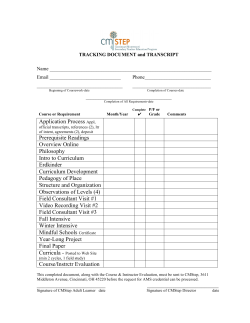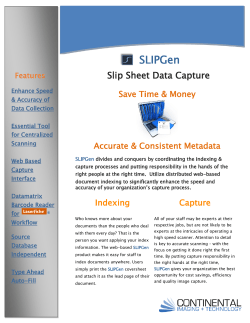
Poster
Sources of Evidence for Automatic Indexing of Political Texts
Mostafa Dehghani, Hosein Azarbonyad, Maarten Marx, and Jaap Kamps
University of Amsterdam
Motivation
Experiments
Political texts on the Web, documenting laws and policies and the process leading to
them, are of key importance to government, industry, and every individual citizen.
Data Collection
I Annotated Data: JRC-Acquis
. from 2002 to 2006
. 16,824 documents
I Taxonomy: EuroVoc
. 6,796 hierarchically structured concepts
Experiment 1: Performance of LTR
Laws
Questions
Debates
What laws are being made?
What committees are working on?
What parliaments is talking about?
Performance of JEX, best single feature, and LTR methods.
Research Questions:
I What are the different possible sources of evidence for automatic indexing of political
text?
I How effective is a learning to rank (LTR) approach integrating a variety of sources of
information as features?
Method
JEX
BM25-Titles
LTR-all
P@5 (%Diff.)
0.4353
0.4798 (10%)
0.5206 (20%)
Recall@5 (%Diff.)
0.4863
0.5064 (4%)
0.5467 (12%)
I Exploiting LTR enables us to learn an effective way to combine features from different
sources of evidence.
I What is the relative importance of each of these sources of information for indexing
political text?
Experiment 2: Feature Analysis
I Can we build a lean-and-mean system that approximate the effectiveness of the large
LTR system?
lit
y
ne
ra
Ch
ild
ty
(#
gu
i
Ge
ity
Am
er
en
bi
)
gu
ity
(#
Pa
re
nt
s)
M
(t
itl
e_
D)
Labeled
Documents
Po
pu
lar
-M
(t
M
itl
(t
e_
ex
C)
t_
_B
D)
M
-M
25
(t
M
e
xt
(t
_C
ex
t_
)_
D)
BM
-M
25
(t
M
i
tle
(t
_C
itl
e_
)_
D)
BM
-M
25
(t
M
e
xt
(t
itl
_C
e_
)_
D)
BM
-M
25
(d
M
e
sc
(t
ex
_C
t_
)_
D)
BM
M
-M
(t
25
(d
ex
es
t_
c_
D)
C)
-M
_B
(
an
M
M
c_
(t
25
itl
de
e_
sc
D)
_C
-M
)_
(a
BM
nc
25
_d
es
c_
C)
_B
M
25
I Different sources of evidence for the selection of appropriate indexing terms for
political documents:
P@5
SVMRank Weight
Am
bi
Learning to Rank for Sources of Evidence Combination
0.7
0.6
0.5
0.4
0.3
0.2
0.1
0
Feature importance: 1) P @5 of individual features, 2) weights in SVM-Rank model
Textual
Glosses of
Descriptor Terms
Thesaurus
Structure
I Findings:
. Titles can be considered as the most succinct predictor of classes (Titles of political
documents tend to be directly descriptive of the content)
I Mapping Indexing Problem to the Retrieval Problem:
. Popularity is not an effective feature itself, but increases the performance along
with other features.
. Features for reflecting the similarity of descriptor terms and documents:
I Formal models of documents and descriptor terms:
M odelD = hM (titleD ), M (textD )i
M odelDT = hM (titleDT ), M (textDT ), M (glossDT ), M (anc_glossDT )i
Experiment 3: Lean and Mean System
I Selected Features:
Documents
. Similarity of text submodels
. Similarity of title submodels
. Similarity of text and textual glosses of descriptor terms
. Popularity of descriptor terms
..
.
. ..
Title
Text
Performance of LTR on all features, and on four selected features
Description
Query
Method
LTR-all
LTR-ttgp
Features
Similarity
Title
Title
Text
Text
Description
Description
Title
P@5 (%Diff.)
0.5206 (-)
0.5058 (-3%)
all@5 (%Diff.)
0.5467 (-)
0.5301 (-3%)
Text
.
..
..
.
.
..
..
I Selective LTR approach is a computationally attractive alternative to the full
LTR-all approach.
.
Thesaurus structure
I
For each combination, three IR measures are employed: a) language modeling
similarity based on KL-divergence using Dirichlet smoothing, b)the same run using
Jelinek-Mercer smoothing, and c) Okapi-BM25.
. Features for reflecting the characteristics of descriptor terms independent of
documents:
I
Popularity
I
Generality
I
Ambiguity
ExPoSe:Exploratory Political Search,
Conclusion
I Using a learning to rank approach integrating all features has significantly better
performance than previous systems.
I The analysis of feature weights reveals the relative importance of various sources
of evidence, also giving insight in the underlying classification problem.
I A lean and mean system using only four features (text, title, descriptor glosses,
descriptor term popularity) is able to perform at 97% of the large LTR model.
Funded by NWO (project# 314-99-108)
37th European Conference on information retrieval
{dehghani,h.azarbonyad}@uva.nl
© Copyright 2025











